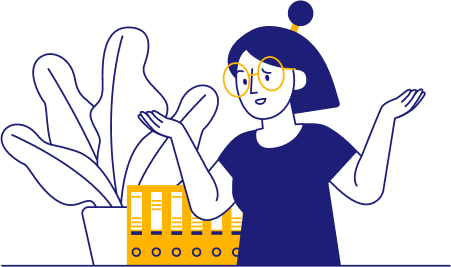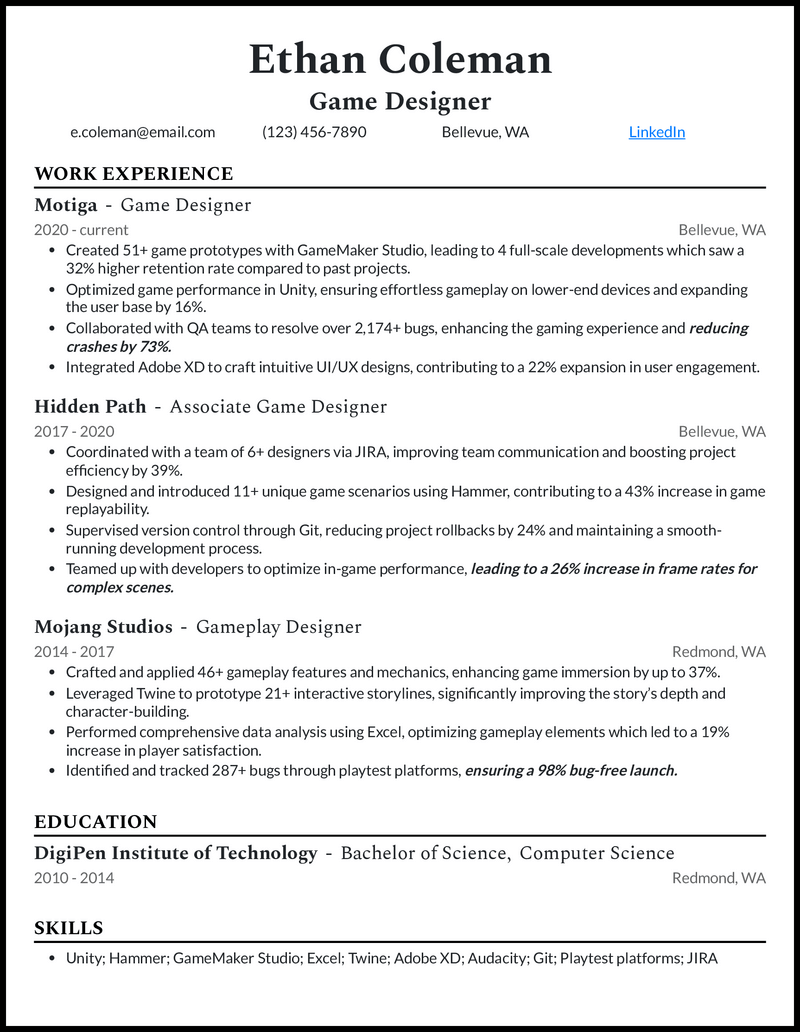You’re passionate about the thrilling ups and downs that games create. Whether you specialize in functional game mechanics, storytelling, or graphics, you know you have the right skills to make a difference for development studios.
Have you put the same effort into selecting your resume template or developing the appearance and descriptions in your resume?
Many game studios will have varying requirements that require you to present the right expertise, from UI to character building. We’ll help you create a cover letter and a custom resume for each company’s needs with our game design resume examples that have landed many jobs in 2026.
Why this resume works
- What makes this game design resume stand out? As you can see, it doesn’t just go over the technical skills but also highlights how effectively Ethan used industry-relevant tools to solve complex problems, such as identifying bugs and reducing crashes.
- Adding quantifiable achievements to this also raises your results, making your work experience more substantial.
Why this resume works
- It’s completely fine to have humble work experience in your college graduate design resume. However, there’s one sneaky way of standing out from the competition.
- Most freshers won’t be able to prove their worth. That’s where you can add the impact of your work in a corporate setting. Use quantified metrics or even better KPIs like user satisfaction ratings to show how your contribution at lower levels made gaming visually fun for everyone.
Why this resume works
- You don’t need the world’s best experience to create an eye-catching game design intern resume. But, and that’s an important but, what you do need is a strong career objective that impresses every employer.
- While writing it, add all projects that show your ability to handle game-designing tasks. Next up is your suite of skills. Include the best ones which every modern-day game development company relies on such as Unity and Adobe Photoshop.
Why this resume works
- Notice how this piece pulls out metrics that show off the candidate’s performance right off the bat. If you’ve impacted a company’s time and performance, don’t forget to list them down.
- This is an incredible way to let the recruiter know your value and leave an impactful impression too! Next, you can bring in your experience working with senior animators and contributing to award-winning campaigns to help your 3D Game Design resume stand out.
Why this resume works
- Your video game design resume will require technical and artistic aptitude but mentioning skills beyond these can give you an edge over other candidates.
- For instance, mention an event where you increased website traffic by creating compelling game trailers. Make sure you add and underscore it specifically to draw attention to your expertise in sales and marketing.
Related resume examples
Write a Game Design Resume That Fits the Job Description

Every game studio will have varying needs depending on the games they create and the software they use in the process. For example, one studio seeking a 3D designer may want you to be proficient in Autodesk Maya, whereas another needs assistance with Substance Painter projects.
Listing a custom set of skills based on each job description will help you stand out with any animation or AI expertise companies want you to have, giving you a better chance of getting calls back for an interview.
Need some ideas?
15 popular game design skills
- Game Prototyping
- Data Modeling
- Python
- ZBrush
- JIRA
- Feedback Loops
- Image Rendering
- 3D Animation
- Dialog Development
- JavaScript
- Maya
- Unity
- Digital Sculpting
- Nvidia Omniverse
- Unreal Engine

Your game design work experience bullet points
Any game that lacks a decent level of gameplay will flop when it hits the market, so every company needs to make sure they hire effective designers for every part of their projects.
The best way to showcase what you can do is with examples of what you’ve achieved in past designer roles, such as implementing automation to finish projects ahead of schedule or using digital sculpting to create 57% more immersive scenery.
The right metrics will help you enhance these examples, so here are some of the best ones for game designers to use on resumes.
- Player satisfaction: The end user is always the biggest concern in design, so player satisfaction ratings are a key sign of success.
- Player counts: Did a game you developed maintain high monthly player counts? This can be a great metric to show your projects keep customers engaged long-term.
- Game stability: Nobody wants a game that crashes, making game stability scores an essential metric to include.
- Data size: Designers who can minimize data and file sizes help create a smoother gaming experience with shorter download times, a win-win all around.
See what we mean?
- Optimized game performance in Unity, ensuring effortless gameplay on lower-end devices and expanding the user base by 16%.
- Designed and introduced 11+ unique game scenarios using Hammer, contributing to a 43% increase in game replayability
- Conducted 516+ hours of game testing to rectify bugs, increasing the game’s stability and performance by 23%.
- Implemented advanced OBS Studio techniques for team communications, which facilitated a 31% improvement in the design workflow efficiency.
9 active verbs to start your game design work experience bullet points
- Designed
- Developed
- Conducted
- Tested
- Built
- Generated
- Enhanced
- Choreographed
- Wrote
3 Tips to Enhance Your Game Design Resume When You’re Inexperienced
- Consider a resume objective
- Don’t have much game design experience? A resume objective can help you emphasize some career goals and skills that make you stand out, such as how you’re a motivated game designer and eager to use your skills in Substance Painter that you picked up while obtaining your interactive design and development degree.
- Add transferable skills
- Have you worked as a data entry clerk and accurately managed essential information? How about working as a junior narrative designer, which will give you top-notch skills to develop great game scripts? Any transferable skills will help you stand out as an applicant.
- Include achievements from projects
- Achievements from academic or community service projects can often enhance your resume when you don’t have much work experience. For example, how you used JIRA in an interactive design class project to identify bugs 78% more accurately.
3 Tips to Make Your Game Design Resume More Successful When You’re Experienced
- Keep it to three or four jobs
- If you’re more experienced, you don’t need to include every job you’ve worked at. Some jobs, like junior game design roles or working as a data entry clerk, can now be removed. Keep to the three or four most recent jobs and use relevant skill sets in aspects like Python or ZBrush.
- List experiences in reverse chronological order
- The game design industry is constantly evolving, with innovations in motion graphics and 3D animation. Therefore, you should list your most recent experiences first to emphasize your most relevant skill set as a game designer.
- Add a resume summary
- Experienced game designers may benefit from a resume summary. For example, you could write a few sentences on how you’ve worked on 27 digital sculpting projects using Maya to boost player engagement by an average of 45%.
Aim to keep your game design resume on a single page. It should contain brief and relevant information based on each company’s needs, such as abilities in dialog development and story arcs for a company seeking help with game scripting.
Action verbs like “developed” or “enhanced” will make your examples more impactful. For instance, rather than just saying you’re “proficient in Python,” it would sound more engaging to say you “developed 3D graphics 35% more efficiently by using Python in the coding process.”
The best way to stand out amongst game design applicants will be getting as specific as possible to each job’s needs while including metrics from your achievements. For example, a design studio concerned with enhancing the end-user experience may appreciate your UI development and debugging skills that help boost player satisfaction by 53%.










